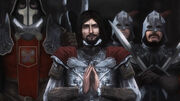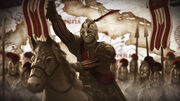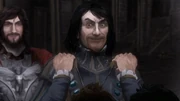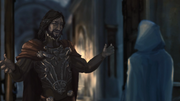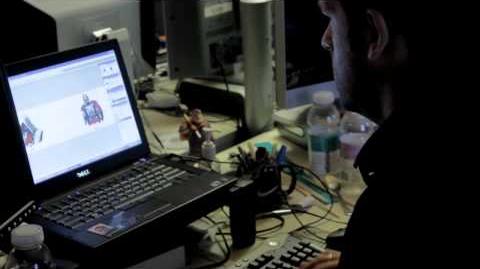No edit summary |
|||
| (39 intermediate revisions by 22 users not shown) | |||
| Line 1: | Line 1: | ||
| + | {{DISPLAYTITLE:''{{PAGENAME}}''}} |
||
| − | {{era|ac2|acb|Ascendance|realworld}} |
||
| + | {{Era|AC2|ACB|ACA|RW}} |
||
| − | {{Working Revamp|War Clown}} |
||
{{WP-REAL}} |
{{WP-REAL}} |
||
{{Film Infobox |
{{Film Infobox |
||
| − | | |
+ | |name = Assassin's Creed: Ascendance |
| − | | |
+ | |image = Title asscend.jpeg |
| − | | |
+ | |director = Laurent Bernier <small>'''(Director)'''</small> / Ghislain Ouellet <small>'''(Assistant Director)'''</small> |
| − | | |
+ | |producer = Louis-Pierre Pharmand <small>'''(Producer)'''</small> / Jean-Jacques Tremblay <small>'''(Associate Producer)'''</small> / Yves Guillemot, Serge Hascoet, Yannis Mallat, Sebastien Puel <small>'''(Executive Producers)'''</small> |
| − | | |
+ | |writer = Ethan Perry <small>'''(Screenplay)'''</small> / Jean Guesdon, Ethan Petty, Louis-Pierre Pharmand, Jeffrey Yohalem <small>'''(Story)'''</small> |
| − | | |
+ | |narrator = |
| − | | |
+ | |starring = [[Roger Craig Smith]], [[Andreas Apergis]], [[Carlos Ferro]], [[Arthur Holden]], [[Harry Standjofski]] <br><small>'''(Voice Talents)'''</small> |
| − | | |
+ | |music = [[Jesper Kyd]], Inon Zur |
| − | | |
+ | |cinematography = Nicolas Drolet |
| − | | |
+ | |editing = Nicolas Drolet, Ghislain Ouellet <br><small>'''(Art Department)'''</small> |
| − | | |
+ | |studio = Ubiworkshop, [[Ubisoft]] Montreal Studios |
| − | | |
+ | |distributor = Ubisoft Montreal |
| − | | |
+ | |released = 16 November 2010 |
| − | | |
+ | |runtime = 13:32 |
| − | | |
+ | |country = [[Canada]] |
| − | | |
+ | |language = {{Wiki|English language|English}} |
| − | | |
+ | |budget = |
| − | | |
+ | |gross = |
| − | | |
+ | |preceded_by = ''[[Assassin's Creed II]]'' |
| − | | |
+ | |followed_by = ''[[Assassin's Creed: Brotherhood]]''}} |
| ⚫ | '''''Assassins Creed: Ascendance''''' is a short, animated film project created to expand the [[Assassin's Creed (series)|''Assassin's Creed'' series]]. It was revealed by [[Ubiworkshop]] on 10 November 2010, and was released on 16 November 2010 for PlayStation Store, Xbox LIVE, and iTunes.<ref>[http://ubiworkshop.myshopify.com/blogs/news/2266192-assassins-creed-ascendance-announcement UbiWorkshop's ''Assassin's Creed: Ascendance'' Official Announcement]</ref> |
||
| − | |||
| ⚫ | '''''Assassins Creed: Ascendance''''' is a short, animated film project created to expand the [[Assassin's Creed (series)|''Assassin's Creed'' series]]. It was revealed by [ |
||
Created as a bridge between ''[[Assassin's Creed II]]'' and ''[[Assassin's Creed: Brotherhood]]'', the short film details more of [[Cesare Borgia]]'s rise to power. |
Created as a bridge between ''[[Assassin's Creed II]]'' and ''[[Assassin's Creed: Brotherhood]]'', the short film details more of [[Cesare Borgia]]'s rise to power. |
||
| + | |||
==Plot== |
==Plot== |
||
| − | After the [[ |
+ | After the [[Siege of Monteriggioni|destruction]] of [[Monteriggioni]] in the year 1500, the Assassin [[Ezio Auditore da Firenze]] met with [[Leonardo da Vinci]] in the streets of [[Rome]] to obtain information about the [[Rodrigo Borgia|Pope]]'s son, Cesare Borgia. Forewarned about the man he wished to know, Ezio wanted to learn more nevertheless. What followed was a reliving of Cesare's ascension to power. |
| − | During the year 1497, Rodrigo's son, [[Juan Borgia the Younger |
+ | During the year 1497, Rodrigo's son, [[Juan Borgia the Younger]], was named Captain General of the [[Papacy|Papal]] armies, while Cesare was named one of the [[cardinals]]. Not content with the position given to him, Cesare planned to eliminate his brother. With the assistance of the [[Courtesans|courtesan]] [[Fiora Cavazza]], Cesare had his brother killed in bed, and his body subsequently thrown in the [[Tiber]] river. Left with no other substitute, Rodrigo named Cesare the new Captain General. |
| − | Cesare would then begin a conquest for [[Romagna]] in late 1499 with [[Ramiro d'Orco]], [[Oliverotto da Fermo]], and [[Vitellozzo Vitelli]] leading his armies. However, in the midst of their conquest, several of his subjects began to rebel against him. In response, Cesare had Ramiro beheaded and framed his other generals, feeling that he no longer had use for them. Fearing that they could be next, the remaining generals conspired against Cesare, and began a rebellion in the year 1502. The two generals won several battles and even managed to take over several of Cesare's lands. |
+ | Cesare would then begin a conquest for [[Romagna]] in late 1499 with [[Ramiro d'Orco]], [[Oliverotto da Fermo]], and [[Vitellozzo Vitelli]] leading his armies. However, in the midst of their conquest, several of his subjects began to rebel against him. In response, Cesare had Ramiro beheaded and framed his other generals, feeling that he no longer had use for them. Fearing that they could be next, the remaining generals, Oliverotto and Vitellozzo, conspired against Cesare, and began a rebellion in the year 1502. The two generals won several battles and even managed to take over several of Cesare's lands. |
| + | [[File:CesareEzio.png|thumb|250px|Ezio vowing to kill Cesare, no matter the odds]] |
||
| − | Hearing the demands of Oliverotto and Vitellozzo, Cesare promised to accept them all, |
+ | Hearing the demands of Oliverotto and Vitellozzo, Cesare promised to accept them all, assuring that they would return to his service and their past atrocities be forgiven. After a few months, Cesare held a dinner in their honor, though it was later revealed by Cesare to be an ambush, and he had the two generals captured. Cesare then ordered [[Micheletto Corella]] to strangle them to death. Reclaiming the lands taken from him, Cesare earned the praise and respect of both his allies and his enemies. |
| − | By then, Cesare had surrounded himself with several figures of power and talented people, such as Leonardo da Vinci, and several other individuals. Hearing enough, Ezio |
+ | By then, Cesare had surrounded himself with several figures of power and talented people, such as Leonardo da Vinci, and several other individuals. Hearing enough, Ezio vowed to kill Cesare, despite his reputation. After receiving a scroll from Ezio, Leonardo returned to the side of Cesare in order to resume work on his [[War Machines]]. As Leonardo entered the [[Castel Sant'Angelo]], Ezio returned to the city, declaring that Rome's corruption would end. |
==Media== |
==Media== |
||
| − | The art style of the entire animation was made to be a balance between what the animators were comfortable with |
+ | The art style of the entire animation was made to be a balance between what the animators were comfortable with and the traditional oil-paint style iconic to the [[Renaissance]] era.<ref name="Making of">The Making of ''Assassin's Creed: Ascendance''</ref> |
| − | Additionally, the |
+ | Additionally, the creators wished for the film to be familiar to the fans of the series. To achieve this, they used sound effects and backgrounds taken directly from ''Assassin's Creed: Brotherhood'', such as the Papal apartments in the Castel Sant'Angelo, and the [[Tiber Island headquarters|headquarters]] on [[Tiber Island]].<ref name="Making of"/> |
==Trivia== |
==Trivia== |
||
*The film was originally named "Secret Project Number Three" by UbiWorkshop.<ref>[http://kotaku.com/5686463/ubiworkshop-reveals-assassins-creed-ascendance ''Assassin's Creed: Ascendance'' teaser]</ref> |
*The film was originally named "Secret Project Number Three" by UbiWorkshop.<ref>[http://kotaku.com/5686463/ubiworkshop-reveals-assassins-creed-ascendance ''Assassin's Creed: Ascendance'' teaser]</ref> |
||
| − | *A variation of [[Octavian de Valois]]' death is |
+ | *A variation of [[Octavian de Valois]]' death is shown in the introduction of the short film. There, Octavian and several of his men held [[Pantasilea Baglioni]] hostage in the Roman Forum, and were attacked by Ezio, who was wearing his [[Ezio Auditore's robes|usual Assassin robes]]. Ezio would then strike from above and stab Octavian with his [[Hidden Blade]]. |
| − | **Octavian's final words also |
+ | **Octavian's final words also differed from the ones spoken in ''Assassin's Creed: Brotherhood'', saying that he only played a small part in Cesare's plans, rather than him admitting his desire for respect. |
| − | *Juan Borgia's murder appears to have taken place in the [[Tiber Island |
+ | *Juan Borgia's murder appears to have taken place in the [[Tiber Island headquarters]]. Whether this is considered canon or not is yet to be confirmed. |
| + | *The building where Oliverotto and Vitellozzo's dinner supposedly took place appears to be the [[Borgia Towers|Borgia Tower]] nearest to the [[Caserma di Alviano]] that kept [[Bartolomeo d'Alviano]]'s forces at bay, until Ezio destroyed the building. However, this causes conflict in the timeline, as Ezio destroyed and had the Assassin Order occupy the tower in 1500, while the murders of both generals took place in 1502. |
||
| − | *The film is one of the few instances where Cesare uses a [[Crossbow|crossbow]] is seen, utilizing it to subdue Oliverotto. |
||
| − | + | *The film shows one of the few instances where Cesare was seen using a [[crossbow]], utilizing it to subdue Oliverotto. The crossbow Cesare possessed in the film had a unique design, embedded with a small metal decal of a woman. |
|
| + | *The film is included with the ''[[Assassin's Creed: Lineage]]'' Blu-ray disc. |
||
==Gallery== |
==Gallery== |
||
| + | <tabber>Images= |
||
| − | <gallery widths="180" captiontextcolor="#ffffff" bordersize="medium" captionalign="center"> |
||
| + | <gallery captionalign="center" position="center" spacing="small" widths="180"> |
||
| − | + | cesare screenshot large.jpg|Cesare with his men |
|
| − | + | ezio screenshot large.jpg|Ezio before Octavian de Valois |
|
| − | + | Papal guard screenshot_large.jpg|The Borgia forces in their conquest for Romagna |
|
| − | JuanGeneral.png|Juan Borgia, as Captain General. |
||
| − | + | JuanGeneral.png|Juan Borgia as Captain General |
|
| + | JuanDeath.png|Juan Borgia's death |
||
| − | FermoandVettoCaptured.png|Oliverotto and Vitellozzo, moments before their death |
+ | FermoandVettoCaptured.png|Oliverotto and Vitellozzo, moments before their death |
| − | MichelottoCesare.png|Micheletto |
+ | MichelottoCesare.png|Micheletto strangling the conspirators |
| − | CesareLeo.png|Cesare |
+ | CesareLeo.png|Cesare greeting Leonardo da Vinci |
</gallery> |
</gallery> |
||
| + | |-| |
||
| − | {{-}} |
||
| ⚫ | |||
| − | |||
| + | <gallery captionalign="center" position="center" spacing="small" widths="180"> |
||
| ⚫ | |||
| − | + | Assassin's Creed Ascendance - Teaser|''Assassin's Creed: Ascendance'' Teaser Trailer |
|
| − | + | Assassin's Creed Ascendance - Making Of|''Assassin's Creed: Ascendance'' - Making Of |
|
| + | </gallery> |
||
| − | {{-}} |
||
| + | </tabber> |
||
==References== |
==References== |
||
| − | {{ |
+ | {{Reflist}} |
| − | |||
{{ACSeries}} |
{{ACSeries}} |
||
| + | |||
| ⚫ | |||
| − | [[ |
+ | [[de:Assassin’s Creed: Ascendance]] |
| + | [[es:Assassin's Creed: Ascendance]] |
||
| + | [[hu:Assassin's Creed: Ascendance]] |
||
| + | [[it:Assassin's Creed: Ascendance]] |
||
| + | [[lt:Assassin's Creed: Ascendance]] |
||
| + | [[ru:Assassin's Creed: Господство]] |
||
| + | [[uk:Assassin's Creed: Ascendance]] |
||
| ⚫ | |||
| + | [[Category:Real world short films|Ascendance]] |
||
Revision as of 16:54, 9 March 2020
Assassins Creed: Ascendance is a short, animated film project created to expand the Assassin's Creed series. It was revealed by Ubiworkshop on 10 November 2010, and was released on 16 November 2010 for PlayStation Store, Xbox LIVE, and iTunes.[1]
Created as a bridge between Assassin's Creed II and Assassin's Creed: Brotherhood, the short film details more of Cesare Borgia's rise to power.
Plot
After the destruction of Monteriggioni in the year 1500, the Assassin Ezio Auditore da Firenze met with Leonardo da Vinci in the streets of Rome to obtain information about the Pope's son, Cesare Borgia. Forewarned about the man he wished to know, Ezio wanted to learn more nevertheless. What followed was a reliving of Cesare's ascension to power.
During the year 1497, Rodrigo's son, Juan Borgia the Younger, was named Captain General of the Papal armies, while Cesare was named one of the cardinals. Not content with the position given to him, Cesare planned to eliminate his brother. With the assistance of the courtesan Fiora Cavazza, Cesare had his brother killed in bed, and his body subsequently thrown in the Tiber river. Left with no other substitute, Rodrigo named Cesare the new Captain General.
Cesare would then begin a conquest for Romagna in late 1499 with Ramiro d'Orco, Oliverotto da Fermo, and Vitellozzo Vitelli leading his armies. However, in the midst of their conquest, several of his subjects began to rebel against him. In response, Cesare had Ramiro beheaded and framed his other generals, feeling that he no longer had use for them. Fearing that they could be next, the remaining generals, Oliverotto and Vitellozzo, conspired against Cesare, and began a rebellion in the year 1502. The two generals won several battles and even managed to take over several of Cesare's lands.
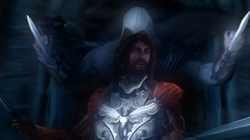
Ezio vowing to kill Cesare, no matter the odds
Hearing the demands of Oliverotto and Vitellozzo, Cesare promised to accept them all, assuring that they would return to his service and their past atrocities be forgiven. After a few months, Cesare held a dinner in their honor, though it was later revealed by Cesare to be an ambush, and he had the two generals captured. Cesare then ordered Micheletto Corella to strangle them to death. Reclaiming the lands taken from him, Cesare earned the praise and respect of both his allies and his enemies.
By then, Cesare had surrounded himself with several figures of power and talented people, such as Leonardo da Vinci, and several other individuals. Hearing enough, Ezio vowed to kill Cesare, despite his reputation. After receiving a scroll from Ezio, Leonardo returned to the side of Cesare in order to resume work on his War Machines. As Leonardo entered the Castel Sant'Angelo, Ezio returned to the city, declaring that Rome's corruption would end.
Media
The art style of the entire animation was made to be a balance between what the animators were comfortable with and the traditional oil-paint style iconic to the Renaissance era.[2]
Additionally, the creators wished for the film to be familiar to the fans of the series. To achieve this, they used sound effects and backgrounds taken directly from Assassin's Creed: Brotherhood, such as the Papal apartments in the Castel Sant'Angelo, and the headquarters on Tiber Island.[2]
Trivia
- The film was originally named "Secret Project Number Three" by UbiWorkshop.[3]
- A variation of Octavian de Valois' death is shown in the introduction of the short film. There, Octavian and several of his men held Pantasilea Baglioni hostage in the Roman Forum, and were attacked by Ezio, who was wearing his usual Assassin robes. Ezio would then strike from above and stab Octavian with his Hidden Blade.
- Octavian's final words also differed from the ones spoken in Assassin's Creed: Brotherhood, saying that he only played a small part in Cesare's plans, rather than him admitting his desire for respect.
- Juan Borgia's murder appears to have taken place in the Tiber Island headquarters. Whether this is considered canon or not is yet to be confirmed.
- The building where Oliverotto and Vitellozzo's dinner supposedly took place appears to be the Borgia Tower nearest to the Caserma di Alviano that kept Bartolomeo d'Alviano's forces at bay, until Ezio destroyed the building. However, this causes conflict in the timeline, as Ezio destroyed and had the Assassin Order occupy the tower in 1500, while the murders of both generals took place in 1502.
- The film shows one of the few instances where Cesare was seen using a crossbow, utilizing it to subdue Oliverotto. The crossbow Cesare possessed in the film had a unique design, embedded with a small metal decal of a woman.
- The film is included with the Assassin's Creed: Lineage Blu-ray disc.
Gallery
References
- ↑ UbiWorkshop's Assassin's Creed: Ascendance Official Announcement
- ↑ 2.0 2.1 The Making of Assassin's Creed: Ascendance
- ↑ Assassin's Creed: Ascendance teaser

